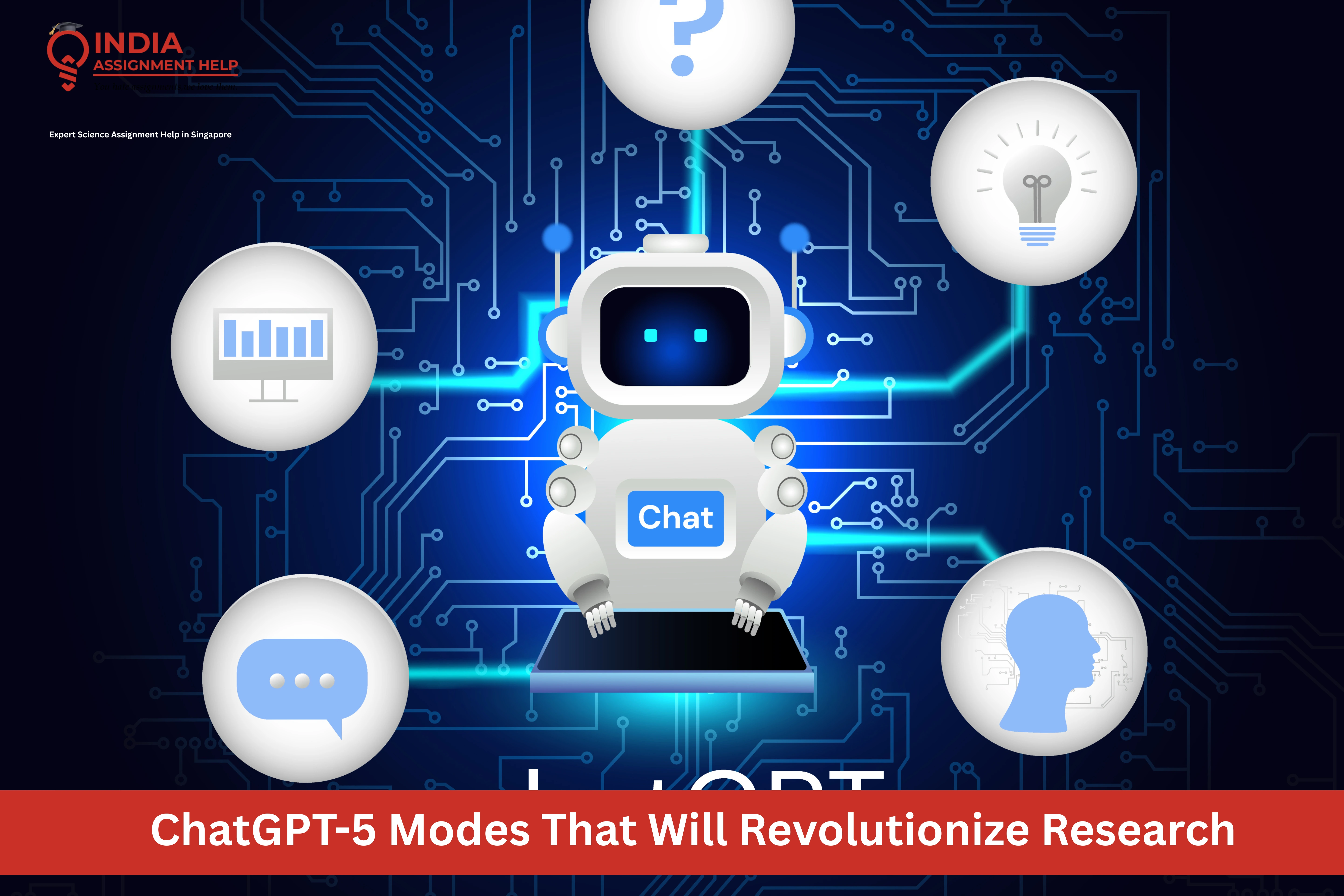ChatGPT-5 Modes That Will Change Research Forever In 2025

AI is still relatively new in 2025; however, the time when Large Language Models (LLMs) were viewed merely as writing assistants has largely passed. ChatGPT is considered to be the most popular general-purpose AI tool used by people in today’s time, and it is also heralded as a revolutionary LLM that changed the development of AI forever. Although OpenAI’s GPT-4 model has definitely set new expectations for LLMs by improving its research resourcefulness by revolutionizing literature reviews and thesis drafting, GPT-5 appears to promise more.
GPT-5 has made significant strides in personalization and improved functionality, which is the focus of today’s blog. We will discuss the latest modes of GPT-5 that will transform LLMs from being a background tool to an effective partner that will very likely change the future of AI-powered research support for years to come.
What Are ChatGPT-5 Modes?
Let us begin by dissecting the GPT-5 modes we discussed in the beginning, as they are our central focus here. GPT-5 has essentially evolved ChatGPT from being a single-purpose AI tool to becoming a multipurpose research assistant in a way that was never seen before. These models, or AI services, can be described as pre-configured environments that optimize the model’s parameters, access, and output style to achieve maximum efficiency for certain tasks.
There are four models that we will be discussing further. These are the Study Mode, the Listener Mode, the Thinking Mode, and the Dictation Mode. Each of these models is designed to personalize the user’s experience and provide better results for research in record times. In fact, you can say that the use of AI in research projects has never been more personalized. Let us look at each of the GPT-5 models in detail in the coming sections.
Study Mode: What Can It Do?
We’ll start by discussing one of the best academic AI tools that OpenAI has gifted us with in its latest GPT update, the study mode. What it does is that it helps in structured learning and content creation that adheres to institutional standards. One thing that the study mode is especially good at is drafting a study plan. You see, if you have a peer review or a professor review for one of your papers, then you can simply give the review to GPT-5, and based on the reviewer’s suggestions, you will get an effective study/research plan.
The advantages of the study mode are quite a few. It claims to be seamlessly integrated with external research databases, which allows it to build bibliographies and literature reviews in no time. And we mean it, as it often takes less than 1 minute to do so. Another reason why the study mode makes GPT-5 a great AI for research is that it is remarkably good at finding citations.
Whenever you source a piece of information from the study mode, it will give you a comprehensive list of actual, verified sources for you to analyze. If you want, the AI can also provide a comparative analysis of the methodologies and summaries of all its sources.
Listener Mode: A Brand New Innovation In AI Personalization
Now let’s talk about the listener mode, shall we? As of now, the audio input processing abilities of GPT-5 are possibly among the best in the world. The listening mode leverages the same capabilities to take digital notes and synthesize them at the moment you speak to the AI. Its main purpose is to provide AI research assistance during meetings, lectures, or interviews.
What’s even more surprising is that the listener mode can differentiate between different speakers and generate responses at the same time that the speaker is giving their input. The sheer speed and efficiency of listener mode alone make it one of the most innovative AI-powered research support tools that have come out recently.
What Are Dictation Hacks? How Does Dictation Work In GPT-5?
Speaking of the dictation mode, it works very similarly to the listening mode. This mode prioritizes speed, voice-to-text accuracy, and efficient manuscript generation. It is best suited for hands-free content creation and low latency, which allows it to easily convert audio into text. You can say that it is one of the fastest AI services that GPT-5 can provide.
You can also do highly advanced research planning with the dictation mode. Researchers can simply talk their first draft into existence and simultaneously dictate revisions or corrections. This will boost the writing and editing process so much that it will become almost impossible not to consider AI for research for anyone who uses it.
GPT-5 Thinking Mode: A Hallmark in AI Research Assistance?
The thinking mode is also known as the ‘reasoning engine,’ as it is used for tasks that require complex, multi-step problem-solving and meta-cognitive tracking. You can give it a complex problem like ‘Design a clinical trial protocol for X drug,’ and it will not give you a single unified response. What it’ll do is it will break down the task into sequential steps, explore multiple paths, and detail its own reasoning process. This is one of the main reasons why GPT-5 is currently one of the best examples of the usage of AI in research projects.
Also, did we mention that by breaking down the research process into multiple steps, it essentially makes the process laid out and transparent for your convenience. It will also allow you to verify the process of AI-generated results, making it easier for you to debug flaws if there are any. Keep in mind that the thinking mode is one of the most rapidly developing academic AI tools, so expect further improvements in the near future.
Do GPT-5 Academic AI Services Need Improvement?
Unfortunately, for all the good that GPT-5 can do in terms of research usefulness, there are things that are in serious need of improvement. Each model has some issues that need to be resolved, and we’ll be looking at each of them in detail. Here are some of the most pressing issues that diminish the credibility of GPT-5 as a suitable AI for research.
Study Mode Shortcomings
1) The Data Access Bias:-
Although study mode is helpful for getting open-access papers, it might prioritize digital abstracts and open-source data instead of the full information.
2) Confirmation Over Novelty:-
Study mode AI research assistance can synthesize summaries of papers and come to a conclusion; however, that can be a problem. It can end up overweighting the majority of views and downplaying truly groundbreaking research that goes against the flow.
3) Methodological Blindness:-
The study mode is good for getting a summary of the results of a paper or multiple papers, for that matter; it is sadly not very good at going in-depth with the methodology used.
Listener Mode Shortcomings
1) Contextual Misinterpretation:-
Listener mode is excellent at transcription; however, it is the absolute opposite when it comes to understanding non-verbal cues and implied meaning. Simply put, it has the habit of taking words too literally.
2) Speaker Attribution Errors:-
We have discussed that the listener mode is good at differentiating speakers, but it really isn’t in a crowded environment. Unsurprisingly, that was an expected problem with audio-based AI-powered research support tools are likely to face.
3) Privacy and Data Overload:-
Having the listener mode constantly on during lectures and meetings raises several privacy issues. Also, the data capacity of the listener mode is still not very high, so that’s also a problem.
Thinking Mode Shortcomings
1) Transparent but Flawed Logic:-
The thinking mode has a pretty transparent ‘thinking’ process, but it has a tendency to hallucinate logic and make up rules that do not exist.
2) Computational Bottleneck:-
Getting academic AI tools to think is a very complex computational process. The sheer complexity of the process means that sometimes, the result might resemble an overcooked dish because of too much processing.
3) Bias Amplification:-
If the model’s training data contains biases to certain assumptions and outcomes, it might cloud the AI’s judgment. After all, it is pretty easy to convince most AI that their answers are incorrect.
Dictation Mode Shortcomings
1) Premature Polish:-
Real-time transcription and editing at the same time lead to the over-smoothing of the draft. Creating a rough draft is a fundamental part of the research process, yet the AI still doesn’t understand how to properly create a rough draft.
2) Citation Drift and Formatting Errors:-
Speech is generally not the most effective way to instruct the AI about citations. Even a small citation mistake can lead to hours of wasted time, which is why AI in research projects is not exactly the most reliable.
3) Dependence on Clear Speech:-
Poor audio input and background noise can very easily derail a speech. Even though the AI is being developed further, this is a problem that mostly stems from the user’s surroundings.
Is GPT-5 A Good AI For Research?
In conclusion, all we can say is that there are still far too many issues that GPT-5 still needs to address. If we sideline the issues for a bit, we can say that GPT-5 models are undeniably some of the best and most revolutionary innovations in AI-powered research support technologies. Should we use it in research? Well, that’s your call! However, it is still strongly recommended that you refrain from indulging too much in AI use for research purposes.
AI is still in a development phase, and it is not out of the realm of possibility that it provides inaccurate results. But if you want to use AI for research, then you can start by using it as a research tool for citations, formatting, and grammar checking.
Final Thoughts
All we’d like to say in the end is that GPT-5 is nothing short of revolutionary, adding another feather to OpenAI’s already feather-covered cap. You can safely expect that OpenAI will continue to improve its GPT model, and maybe, the next version will give us something that will make ChatGPT unequivocally the best among academic AI tools. If you want to know more about using AI for research and how to leverage AI for different purposes, then you can contact our team of expert AI professionals at India Assignment Help!





